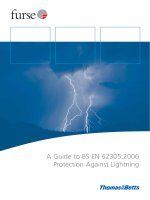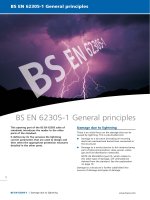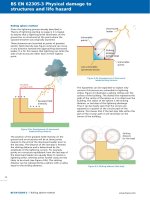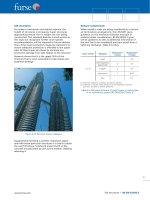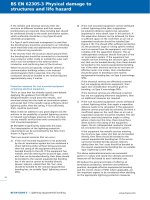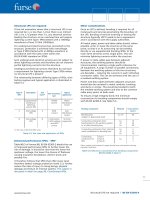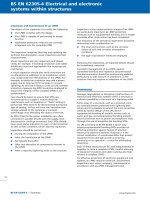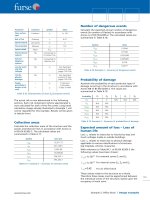Bsi bs en 00438 1 2016
Bạn đang xem bản rút gọn của tài liệu. Xem và tải ngay bản đầy đủ của tài liệu tại đây (965.72 KB, 14 trang )
BS EN 438-1:2016
BSI Standards Publication
High-pressure decorative
laminates (HPL) — Sheets
based on thermosetting resins
(usually called laminates)
Part 1: Introduction and general
information
BS EN 438-1:2016
BRITISH STANDARD
National foreword
This British Standard is the UK implementation of EN 438-1:2016.
It supersedes BS EN 438-1:2005 which is withdrawn.
The UK participation in its preparation was entrusted to Technical
Committee PRI/76, Laminated sheet for decorative purposes.
A list of organizations represented on this committee can be
obtained on request to its secretary.
This publication does not purport to include all the necessary
provisions of a contract. Users are responsible for its correct
application.
© The British Standards Institution 2016.
Published by BSI Standards Limited 2016
ISBN 978 0 580 87153 5
ICS 83.140.20
Compliance with a British Standard cannot confer immunity from
legal obligations.
This British Standard was published under the authority of the
Standards Policy and Strategy Committee on 29 February 2016.
Amendments/corrigenda issued since publication
Date
Text affected
BS EN 438-1:2016
EN 438-1
EUROPEAN STANDARD
NORME EUROPÉENNE
EUROPÄISCHE NORM
February 2016
ICS 83.140.20
Supersedes EN 438-1:2005
English Version
High-pressure decorative laminates (HPL) - Sheets based
on thermosetting resins (usually called laminates) - Part 1:
Introduction and general information
Stratifiés décoratifs haute pression (HPL) - Plaques à
base de résines thermodurcissables (communément
appelées stratifiés) - Partie 1: Introduction et
informations générales
Dekorative Hochdruck-Schichtpressstoffplatten (HPL)
- Platten auf Basis härtbarer Harze (Schichtpressstoffe)
- Teil 1: Einleitung und allgemeine Informationen
This European Standard was approved by CEN on 13 December 2015.
CEN members are bound to comply with the CEN/CENELEC Internal Regulations which stipulate the conditions for giving this
European Standard the status of a national standard without any alteration. Up-to-date lists and bibliographical references
concerning such national standards may be obtained on application to the CEN-CENELEC Management Centre or to any CEN
member.
This European Standard exists in three official versions (English, French, German). A version in any other language made by
translation under the responsibility of a CEN member into its own language and notified to the CEN-CENELEC Management
Centre has the same status as the official versions.
CEN members are the national standards bodies of Austria, Belgium, Bulgaria, Croatia, Cyprus, Czech Republic, Denmark, Estonia,
Finland, Former Yugoslav Republic of Macedonia, France, Germany, Greece, Hungary, Iceland, Ireland, Italy, Latvia, Lithuania,
Luxembourg, Malta, Netherlands, Norway, Poland, Portugal, Romania, Slovakia, Slovenia, Spain, Sweden, Switzerland, Turkey and
United Kingdom.
EUROPEAN COMMITTEE FOR STANDARDIZATION
COMITÉ EUROPÉEN DE NORMALISATION
EUROPÄISCHES KOMITEE FÜR NORMUNG
CEN-CENELEC Management Centre: Avenue Marnix 17, B-1000 Brussels
© 2016 CEN
All rights of exploitation in any form and by any means reserved
worldwide for CEN national Members.
Ref. No. EN 438-1:2016 E
BS EN 438-1:2016
EN 438-1:2016 (E)
Contents
Page
European foreword ....................................................................................................................................................... 3
1
Scope ........................................................................................................................................................................... 4
2
Normative references ........................................................................................................................................... 4
3
Terms and definitions .......................................................................................................................................... 4
4
Guidance in the use of the standard ................................................................................................................ 5
5
4.1
4.2
Description of parts......................................................................................................................................................... 5
Applications........................................................................................................................................................................6
Product classification systems .......................................................................................................................... 6
Annex A (informative) Addendum relating to hygienic, health and safety information for
laminates intended for interior use ........................................................................................................................ 8
A.1
Cleanability........................................................................................................................................................... 8
A.2
Hygiene .................................................................................................................................................................. 8
A.3
Contact with foodstuffs .................................................................................................................................... 8
A.4
Dangerous substances ...................................................................................................................................... 8
Bibliography .................................................................................................................................................................... 9
2
BS EN 438-1:2016
EN 438-1:2016 (E)
European foreword
This document (EN 438-1:2016) has been prepared by Technical Committee CEN/TC 249 "Plastics", the
secretariat of which is held by NBN.
This European Standard shall be given the status of a national standard, either by publication of an
identical text or by endorsement, at the latest by August 2016, and conflicting national standards shall
be withdrawn at the latest by August 2016.
Attention is drawn to the possibility that some of the elements of this document may be the subject of
patent rights. CEN [and/or CENELEC] shall not be held responsible for identifying any or all such patent
rights.
This document supersedes EN 438-1:2005.
EN 438, High-pressure decorative laminates (HPL) — Sheets based on thermosetting resins (usually called
laminates), consists of the following parts:
— Part 1: Introduction and general information
— Part 2: Determination of properties
— Part 3: Classification and specifications for laminates less than 2 mm thick intended for bonding to
supporting substrates
— Part 4: Classification and specifications for Compact laminates of thickness 2 mm and greater
— Part 5: Classification and specifications for flooring grade laminates less than 2 mm thick intended for
bonding to supporting substrates
— Part 6: Classification and specifications for Exterior-grade Compact laminates of thickness 2 mm and
greater
— Part 7: Compact laminate and HPL composite panels for internal and external wall and ceiling finishes
— Part 8: Classification and specifications for design laminates
— Part 9: Classification and specifications for alternative core laminates
According to the CEN-CENELEC Internal Regulations, the national standards organizations of the
following countries are bound to implement this European Standard: Austria, Belgium, Bulgaria, Croatia,
Cyprus, Czech Republic, Denmark, Estonia, Finland, Former Yugoslav Republic of Macedonia, France,
Germany, Greece, Hungary, Iceland, Ireland, Italy, Latvia, Lithuania, Luxembourg, Malta, Netherlands,
Norway, Poland, Portugal, Romania, Slovakia, Slovenia, Spain, Sweden, Switzerland, Turkey and the
United Kingdom.
3
BS EN 438-1:2016
EN 438-1:2016 (E)
1 Scope
This part of EN 438 gives an overview of the standard, and provides guidance in the selection and
application of test methods and specifications contained in EN 438-2, EN 438-3, EN 438-4, EN 438-5,
EN 438-6, EN 438-7, EN 438-8 and EN 438-9.
This European Standard is applicable to high-pressure decorative laminate(s) (HPL) produced by using
a high pressure process.
2 Normative references
The following documents, in whole or in part, are normatively referenced in this document and are
indispensable for its application. For dated references, only the edition cited applies. For undated
references, the latest edition of the referenced document (including any amendments) applies.
EN 438-2, High-pressure decorative laminates (HPL) — Sheets based on thermosetting resins (usually
called Laminates) — Part 2: Determination of properties
EN 438-3, High-pressure decorative laminates (HPL) — Sheets based on thermosetting resins (usually
called laminates) — Part 3: Classification and specifications for laminates less than 2 mm thick intended
for bonding to supporting substrates
EN 438-4, High-pressure decorative laminates (HPL) — Sheets based on thermosetting resins (usually
called laminates) — Part 4: Classification and specifications for Compact laminates of thickness 2 mm and
greater.
EN 438-5, High-pressure decorative laminates (HPL) — Sheets based on thermosetting resins (usually
called laminates) — Part 5: Classification and specifications for flooring grade laminates less than 2 mm
thick intended for bonding to supporting substrates
EN 438-6, High-pressure decorative laminates (HPL) — Sheets based on thermosetting resins (usually
called laminates) — Part 6: Classification and specifications for Exterior-grade Compact laminates of
thickness 2 mm and greater
EN 438-7, High-pressure decorative laminates (HPL) — Sheets based on thermosetting resins (usually
called laminates) — Part 7: Compact laminate and HPL composite panels for internal and external wall
and ceiling finishes
EN 438-8, High-pressure decorative laminates (HPL) — Sheets based on thermosetting resins (usually
called laminates) — Part 8: Classification and specifications for design laminates
EN 438-9, High-pressure decorative laminates (HPL) — Sheets based on thermosetting resins (usually
called laminates) —Part 9: Classification and specifications for alternative core laminates
EN 13329, Laminate floor coverings — Elements with a surface layer based on aminoplastic thermosetting
resins — Specifications, requirements and test methods
3 Terms and definitions
For the purposes of this document, the following terms and definitions apply.
4
BS EN 438-1:2016
EN 438-1:2016 (E)
3.1
high-pressure decorative laminate(s)
HPL
sheet(s) consisting of decorative surface layer(s) and core layers bonded together by a high pressure
process
Note 1 to entry:
MPa.
Typical values for the high pressure process are a temperature of ≥ 120 °C and a pressure of ≥ 5
3.2
surface layer
upper decorative layer consisting in one or more sheets of fibrous material (usually paper) impregnated
with aminoplastic thermosetting resins (usually melamine based resins) or other curable resins or
other decorative design surfaces such as metal foils, wood-veneers and textiles, etc. which are not
necessarily treated with thermosetting resin
Note 1 to entry: The surface layers can appear on one or both side(s) of the laminate(s). In case of one-sided
laminates, the back of the sheet(s) may be made suitable for adhesive bonding to a substrate.
3.3
core layer
fibrous material (usually paper) impregnated with thermosetting resins (usually phenolic based resins)
or other curable resins, eventually reinforced by metal layer(s) or metal mesh(es) and others which are
not necessarily treated with thermosetting resin
4 Guidance in the use of the standard
4.1 Description of parts
EN 438-2 specifies the methods of test that shall be used to determine the performance of HPL products
in their various internal and external application fields, e.g. construction, transport, furniture, flooring,
etc. The test methods have been specifically developed for testing HPL.
It should be noted that not all test methods apply to all types of HPL. For example Test 11, Resistance to
Abrasion, applies only to flooring grade laminates; while Test 10, Resistance to Surface Wear, applies to
all types of HPL except flooring grade laminates. It is therefore important to read the scope of the test
method to determine whether it is applicable to a particular HPL product.
EN 438-3, EN 438-4, EN 438-5, EN 438-6, EN 438-8 and EN 438-9 specify the performance
requirements for different types of high-pressure decorative laminates. Each of these parts is
independent of the others, and only requires reference to EN 438-2 for details of the appropriate test
methods.
EN 438-3 applies to laminates less than 2 mm thick intended for bonding to supporting substrates to
produce HPL composite panels. Classification systems and performance requirements are specified for
heavy duty, horizontal and vertical grades of laminate, in standard, postforming and flame-retardant
qualities.
EN 438-4 applies to Compact laminates of thickness 2 mm and greater, in standard and flame-retardant
qualities, intended for interior applications.
EN 438-5 applies to flooring grade laminates less than 2 mm thick intended for bonding to supporting
substrates, to produce HPL flooring elements. As ‘laminate floor coverings’ they meet the requirements
of EN 13329.
5
BS EN 438-1:2016
EN 438-1:2016 (E)
EN 438-6 applies to Exterior-grade Compact laminates of thickness 2 mm and greater, and specifies
requirements for standard and flame-retardant laminates for use in moderate and severe outdoor
conditions.
EN 438-7 is the harmonised standard covering the essential requirements specified in Construction
Products Regulation for Internal and External Wall and Ceiling Finishes.
EN 438-8 applies to design laminates (pearlescent, wood veneer and metal surfaces).Classification
system and performance requirements are specified for thin and compact laminates.
EN 438-9 applies to alternative core laminates (coloured and metal reinforced cores). Classification
system and performance requirements are specified for thin and compact laminates.
4.2 Applications
Table 1 below shows how the different parts of the standard relate to various fields of application.
Table 1 — Applicable fields
Application
Part 3
Part 4
Construction (internal)
●
●
Transport
●
●
Construction (external)
Furniture
Part 5
Part 6
Part 8
Part 9
●
●
●
●
●
●
●
●
●
Flooring
●
5 Product classification systems
EN 438-3, EN 438-4, EN 438-5, EN 438-6, EN 438-8 and EN 438-9 include product classification
systems. While each of these systems is different, they contain some common elements as follows:
Main classifications:
H denotes Horizontal grade
V denotes Vertical grade
C denotes Compact laminate
E denotes Exterior grade
AC denotes Abrasion Class for flooring grade
A denotes Pearlescent laminate
M denotes Metal laminate
W denotes Wood veneer laminate
B denotes Coloured core laminate
R denotes Metal reinforced core laminate
T denotes Thin laminate < 2 mm
Sub-classifications:
D denotes Heavy duty or severe use
G denotes General purpose or moderate use
S denotes Standard grade
6
BS EN 438-1:2016
EN 438-1:2016 (E)
F denotes Flame-retardant grade
P denotes Postforming grade
In Part 5, the classification system AC1 to AC6 has been adopted as these classes relate directly to the
corresponding product abrasion classes in EN 13329.
7
BS EN 438-1:2016
EN 438-1:2016 (E)
Annex A
(informative)
Addendum relating to hygienic, health and safety information for laminates
intended for interior use
A.1 Cleanability
Because they are easy to clean and maintain, high-pressure decorative laminates are suitable for use in
hygienic applications such as hospitals, pharmacies, food processing areas, abattoirs, clean rooms, etc.
For routine cleaning, wiping the surface with water and mild detergent is usually sufficient, but more
severe methods such as hosing down with hot water or steam cleaning can be used where required by
the application. Solvents such as white spirit, acetone or cellulose thinners can also be used (e.g. for
graffiti removal) as they will not affect the laminate.
For the non melamine surface laminate cleaning, the manufacturer should be contacted.
A.2 Hygiene
When used in hospitals and surgeries, HPL melamine and other curable resin surfaces can be disinfected
using any of the common disinfectants such as Ethanol 70 %, Formalin 1 % to 5 %, p-chlorine-m-cresol
0,3 %, Chloramine T 1 % to 5 %, Alkylbenzyldimethylammonium chloride 0,1 %. High-pressure
decorative laminates show a high resistance to fungal and bacterial growth, when tested in accordance
with EN ISO 846.
A.3 Contact with foodstuffs
When determination of the overall and specific migration is carried out in accordance with the test
method shown below, the following results are typical of those for HPL melamine and other suitable
curable resin surfaces:
Overall migration
Specific migration (formaldehyde)
< 10 mg/dm2
< 2,5 mg/dm2
Test methods - Methods for the examination of consumer goods, basic rules for the determination of the
migration in simulant solvents corresponding to the Commission Regulation (Eu) No 10/2011 of
14 January 2011 and according to the Parts of the EN 1186.
Conditions
Test simulants
Test procedure
24 h at 40 °C
acetic acid with a mass fraction of 3 %
ethanol with a volume fraction of 10 %
ethanol with a volume fraction of 95 %
one-sided contact
A.4 Dangerous substances
Pentachlorophenol, asbestos, halogens or heavy metals (Antimony, Barium, Cadmium, Chromium ΙΙΙ and
VΙ, Lead, Mercury, Selenium) are not used for the production of HPL.
8
BS EN 438-1:2016
EN 438-1:2016 (E)
Bibliography
[1]
EN ISO 846, Plastics — Evaluation of the action of microorganisms (ISO 846)
[3]
EN 1186-2, Materials and articles in contact with foodstuffs — Plastics — Part 2: Test methods for
overall migration into olive oil by total immersion
[2]
[4]
[5]
[6]
[7]
[8]
[9]
[10]
EN 1186-1, Materials and articles in contact with foodstuffs — Plastics — Part 1: Guide to the
selection of conditions and test methods for overall migration
EN 1186-3, Materials and articles in contact with foodstuffs — Plastics — Part 3: Test methods for
overall migration into aqueous food simulants by total immersion
EN 1186-4, Materials and articles in contact with foodstuffs — Plastics — Part 4: Test methods for
overall migration into olive oil by cell
EN 1186-5, Materials and articles in contact with foodstuffs — Plastics — Part 5: Test methods for
overall migration into aqueous food simulants by cell
EN 1186-6, Materials and articles in contact with foodstuffs — Plastics — Part 6: Test methods for
overall migration into olive oil using a pouch
EN 1186-7, Materials and articles in contact with foodstuffs — Plastics — Part 7: Test methods for
overall migration into aqueous food simulants using a pouch
EN 1186-8, Materials and articles in contact with foodstuffs — Plastics — Part 8: Test methods for
overall migration into olive oil by article filling
EN 1186-9, Materials and articles in contact with foodstuffs — Plastics — Part 9: Test methods for
overall migration into aqueous food simulants by article filling
[11]
EN 1186-10, Materials and articles in contact with foodstuffs — Plastics — Part 10: Test methods
for overall migration into olive oil (modified method for use in cases where incomplete extraction of
olive oil occurs)
[12]
EN 1186-11, Materials and articles in contact with foodstuffs — Plastics — Part 11: Test methods
for overall migration into mixtures of 14C-labelled synthetic triglycerides
[13]
[14]
EN 1186-12, Materials and articles in contact with foodstuffs — Plastics — Part 12: Test methods
for overall migration at low temperatures
EN 1186-13, Materials and articles in contact with foodstuffs — Plastics — Part 13: Test methods
for overall migration at high temperatures
[15]
EN 1186-14, Materials and articles in contact with foodstuffs — Plastics — Part 14: Test methods
for 'substitute tests' for overall migration from plastics intended to come into contact with fatty
foodstuffs using test media iso-octane and 95 % ethanol
[16]
EN 1186-15, Materials and articles in contact with foodstuffs — Plastics — Part 15: Alternative test
methods to migration into fatty food simulants by rapid extraction into iso-octane and/or 95 %
ethanol
9
This page deliberately left blank
This page deliberately left blank
NO COPYING WITHOUT BSI PERMISSION EXCEPT AS PERMITTED BY COPYRIGHT LAW
British Standards Institution (BSI)
BSI is the national body responsible for preparing British Standards and other
standards-related publications, information and services.
BSI is incorporated by Royal Charter. British Standards and other standardization
products are published by BSI Standards Limited.
About us
Revisions
We bring together business, industry, government, consumers, innovators
and others to shape their combined experience and expertise into standards
-based solutions.
Our British Standards and other publications are updated by amendment or revision.
The knowledge embodied in our standards has been carefully assembled in
a dependable format and refined through our open consultation process.
Organizations of all sizes and across all sectors choose standards to help
them achieve their goals.
Information on standards
We can provide you with the knowledge that your organization needs
to succeed. Find out more about British Standards by visiting our website at
bsigroup.com/standards or contacting our Customer Services team or
Knowledge Centre.
Buying standards
You can buy and download PDF versions of BSI publications, including British
and adopted European and international standards, through our website at
bsigroup.com/shop, where hard copies can also be purchased.
If you need international and foreign standards from other Standards Development
Organizations, hard copies can be ordered from our Customer Services team.
Subscriptions
Our range of subscription services are designed to make using standards
easier for you. For further information on our subscription products go to
bsigroup.com/subscriptions.
With British Standards Online (BSOL) you’ll have instant access to over 55,000
British and adopted European and international standards from your desktop.
It’s available 24/7 and is refreshed daily so you’ll always be up to date.
You can keep in touch with standards developments and receive substantial
discounts on the purchase price of standards, both in single copy and subscription
format, by becoming a BSI Subscribing Member.
PLUS is an updating service exclusive to BSI Subscribing Members. You will
automatically receive the latest hard copy of your standards when they’re
revised or replaced.
To find out more about becoming a BSI Subscribing Member and the benefits
of membership, please visit bsigroup.com/shop.
With a Multi-User Network Licence (MUNL) you are able to host standards
publications on your intranet. Licences can cover as few or as many users as you
wish. With updates supplied as soon as they’re available, you can be sure your
documentation is current. For further information, email
BSI Group Headquarters
389 Chiswick High Road London W4 4AL UK
We continually improve the quality of our products and services to benefit your
business. If you find an inaccuracy or ambiguity within a British Standard or other
BSI publication please inform the Knowledge Centre.
Copyright
All the data, software and documentation set out in all British Standards and
other BSI publications are the property of and copyrighted by BSI, or some person
or entity that owns copyright in the information used (such as the international
standardization bodies) and has formally licensed such information to BSI for
commercial publication and use. Except as permitted under the Copyright, Designs
and Patents Act 1988 no extract may be reproduced, stored in a retrieval system
or transmitted in any form or by any means – electronic, photocopying, recording
or otherwise – without prior written permission from BSI. Details and advice can
be obtained from the Copyright & Licensing Department.
Useful Contacts:
Customer Services
Tel: +44 845 086 9001
Email (orders):
Email (enquiries):
Subscriptions
Tel: +44 845 086 9001
Email:
Knowledge Centre
Tel: +44 20 8996 7004
Email:
Copyright & Licensing
Tel: +44 20 8996 7070
Email:

